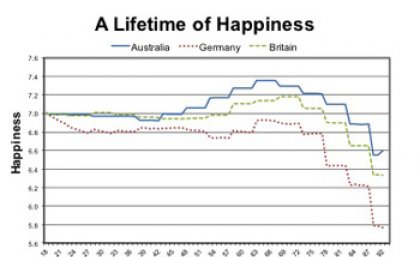
People are at their happiest at retirement age and their most miserable in their geriatric years, a new study has found.
The study into the ‘happiness wave’, conducted by Dr Tony Beatton of Queensland University of Technology and Professor Paul Frijters of The University of Queensland, has revealed how happiness changes over a lifetime for people living in Australia, Germany and Britain.
“We all strive towards happiness, but we wanted to find out at what point in life we actually reach this goal,” said Dr Beatton.
The same study has debunked the idea of the middle-age blues, blaming an over-representation of unhappy respondents in previous surveys.
Collecting data from more than 60,000 people in Australia, Britain and Germany, the pair found people were happiest as they entered retirement age (55-75), and most miserable close to death (80-90).
For a representative 18-year-old with a happiness level of 7 on a 10-point scale, the peak happiness age was found to be 65 in Australia, reaching 7.3, compared with Britain (7.2 at aged 70), and Germany (7 at 65).
“Our interpretation of these findings is that individuals over 55 no longer have unrealistic expectations of what their life will be like and simply enjoy their reasonable health and wealth, leading to a marked surge in happiness. As their health starts to deteriorate after 75, their happiness plunges,” said Dr Beatton.
The study considered figures from three surveys – the Household, Income and Labour Dynamics in Australia (HILDA) survey of 16,000 people in Australia, the British Household Panel Survey (BHPS) of 25,000 in England and the German Socioeconomic Panel Survey (GSOEP) of 20,600 people in Germany.
It found in Australia, happiness peaks at 7.3 by age 65 but then drops increasingly fast as death approaches, with happiness levels at 6.6 at the age of 90 and over.
In Britain, the figures were similar, with the happiness peak slightly later at age 70, and the peak itself not as high as for Australians, reaching only 7.2, then declining to 6.3 over the age of 90.
“Life in old age is clearly relatively better in Australia than the UK, perchance because of the better weather, more generous public pensions, and more space for the grey nomads to roam,” said Dr Beatton.
In Germany, happiness peaks at 7 at age 65, preceded by a reduction in happiness during early adulthood. A sharp drop occurs after age 75. Over 90, happiness level drop to around 5.8.
“Life appears to simply get worse and worse in Germany after the age of 18,” said Dr Beatton.
“Also, it appears mainly miserable middle-aged Germans respond to the GSOEP, and they become more honest and miserable as they answer the questions year after year, leaving problems with the data.”
Previous studies appear to have been hampered by having relatively more middle-aged people in their data than in the actual population.
“Happy people in middle age are busy and don’t have time to participate in lengthy surveys, while more miserable people tend to keep responding to the survey. This led previous studies to erroneously show high degrees of unhappiness in middle-age,” said Dr Beatton.
“If you follow the same people over time however, you do not see this drop in happiness level when people get into their 40s, hence no middle-age ‘U-shaped blues’ pattern can be found, particularly not in Australia or Britain,” he said.
The study has since been published in the Journal of Economic Behaviour and Organisation.
Author: Dr Tony Beatton. School of Economics and Finance, QUT Business School, Queensland University of Technology. Brisbane, Australia (M + 61 402 487 581 or t.beatton@qut.edu.au)
Alternate contact: Professor Paul Frijters. School of Economics, UQ Business School, The University of Queensland. Brisbane, Australia (p.frijters@uq.edu.au).
Downloads: The freely available early working paper version of the study can be found here: http://ideas.repec.org/p/qut/auncer/2008-15.html and the complete published paper is available here: http://dx.doi.org/10.1016/j.jebo.2012.03.008


